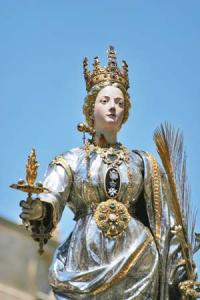
Feast day: 13 December
St Lucy is a very popular saint. She is named in the canon of the mass with eight other women saints, together with Our Lady. There is very little reliable information about her life: many of the details of her story are conventional ones associated with female martyrs of the fourth century. Her legend, however apocryphal, carries spiritual truths.
She came from noble and wealthy parents and was born about the year 283 in Syracuse in Sicily. Her father, who was a Christian, died when she was five. Her mother, Eutychia, suffered from a bleeding disorder and wanted to ensure a secure future for her daughter. She arranged for Lucy to marry a young man from a wealthy pagan family; Lucy, however, wanted to remain a virgin and serve the poor. She persuaded her mother to make a pilgrimage to the shrine of St Agatha who had been martyred in an earlier persecution in Catania. The saint appeared to Lucy in a dream and told her her mother would be cured, which she was. Lucy insisted that her wealth be distributed to the poor. Her suitor, on hearing of this, denounced her to the Roman governor Paschanius who ordered her to burn a sacrifice to the Emperor’s image. When she refused the governor ordered her to be defiled in a brothel, since in that society there was a reluctance to kill virgins. Even with a team of oxen, however, they could not move her from where she was. An attempt was made to burn her and when this failed she was killed with a sword pierced through her neck. There is also a tradition that she was blinded - which was a common practice in the Roman Empire - but that her sight was miraculously restored.
By the sixth century she had become widely venerated and her cult had spread to England by the eighth century. Her name means "light" and since her feast day is in December she is seen as a light bearer in the darkness of winter. In Scandinavia she is represented as a young girl wearing a white dress and red sash (a symbol of martyrdom), carrying palms and wearing a wreath or crown of candles on her head. Lucy is also venerated in many parts of Italy, in the Phillipines, the island of St Lucia and other parts of the world. In Syracuse on the feast of St Lucy, the statue shown above is paraded through the street to the Church of St Lucia where it stays for eight days before being returned to the Duomo. There are celebrations for a week.
St Lucy, pray for us.